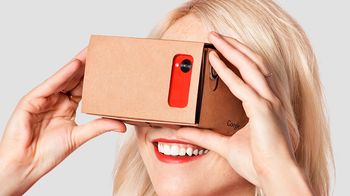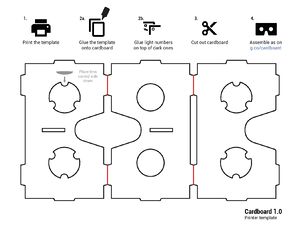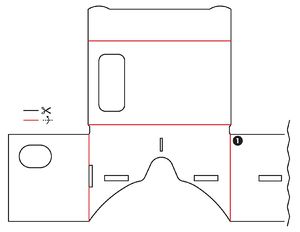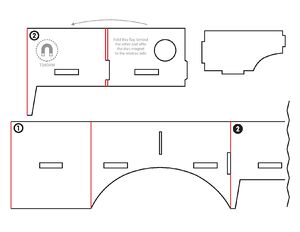Google Cardboard: Difference between revisions
Xinreality (talk | contribs) No edit summary |
Xinreality (talk | contribs) No edit summary |
||
| Line 33: | Line 33: | ||
Google Cardboard, announced in Google I/O on June 25, 2014, is a DIY, cardboard cut-out, smartphone mount developed by [[Google]]. With a smartphone inserted, Google Cardboard allows the user to have a [[Virtual Reality]] experience by holding it close to his or her face. | Google Cardboard, announced in Google I/O on June 25, 2014, is a DIY, cardboard cut-out, smartphone mount developed by [[Google]]. With a smartphone inserted, Google Cardboard allows the user to have a [[Virtual Reality]] experience by holding it close to his or her face. | ||
While Google Cardboard requires a smartphone with stereoscopic display software, this simple and affordable device is constructed with lenses, a magnet, a piece of hook-and-loop fastener and a rubber band. With no official manufacturer, Google has listed the schematics and instructions for the device on its website. Users can either construct one themselves or purchase them from a number of unofficial vendors. | While Google Cardboard requires a smartphone with stereoscopic display software, this simple and affordable device is constructed with lenses, a magnet, a piece of hook-and-loop fastener and a rubber band. With no official manufacturer, Google has listed the schematics and instructions for the device on its website. Users can either construct one themselves or purchase them from a number of unofficial vendors. [[#Version 2|2nd version]] of Google Cardboard was released on May 28, 2015. It replaced the magnetic ring with a universal input button and supported smartphones up to 6 inches in length. | ||
[[Apps]] such as immersive games and concert experiences are available in the Google Play store. Developers familiar with [[OpenGL]] can use [[Cardboard SDK]] for [[Android]] to rapidly create VR apps for the device. | [[Apps]] such as immersive games and concert experiences are available in the Google Play store. Developers familiar with [[OpenGL]] can use [[Cardboard SDK]] for [[Android]] and [[iOS]] to rapidly create VR apps for the device. | ||
==Hardware== | ==Hardware== | ||
===Version 1=== | |||
The core of Google Cardboard is a folded piece of cardboard cutout. The cardboard container serves to mount your smartphone in front of your eyes similar to a set of goggles. Two circular lenses are placed in front of where your eyes should be and used to concentrate your field of view to create immersion. User can slide one of the two magnets placed at the side of the device to interact with the smartphone through the magnetometer. Additionally, an NFC tag can be placed in the device to allow the smartphone app to know when it should be in VR mode and when it should not. | The core of Google Cardboard is a folded piece of cardboard cutout. The cardboard container serves to mount your smartphone in front of your eyes similar to a set of goggles. Two circular lenses are placed in front of where your eyes should be and used to concentrate your field of view to create immersion. User can slide one of the two magnets placed at the side of the device to interact with the smartphone through the magnetometer. Additionally, an NFC tag can be placed in the device to allow the smartphone app to know when it should be in VR mode and when it should not. | ||
===Parts=== | ====Parts==== | ||
'''Cardboard''' - Corrugated cardboard sheet, preferably E Flute (corrugated cardboard comes in a variety of thicknesses called "flutes"), available at many art supply stores and online . For best results, you should look for strong, thin cardboard (sturdy shoe box rather than moving box). Minimum size: 8.75in (22cm) by 22in (56cm), and 0.06in (1.5mm) thickness. | '''Cardboard''' - Corrugated cardboard sheet, preferably E Flute (corrugated cardboard comes in a variety of thicknesses called "flutes"), available at many art supply stores and online . For best results, you should look for strong, thin cardboard (sturdy shoe box rather than moving box). Minimum size: 8.75in (22cm) by 22in (56cm), and 0.06in (1.5mm) thickness. | ||
| Line 53: | Line 54: | ||
'''1 NFC Tag''' (Optional) - One sticker NFC tag. Program it with the URL cardboard://v1.0.0 | '''1 NFC Tag''' (Optional) - One sticker NFC tag. Program it with the URL cardboard://v1.0.0 | ||
===Instructions=== | ====Instructions==== | ||
The following are 3 images. Please print the images then glue the images onto cardboard. Next cut out the cardboard based on the images and construct the device. | The following are 3 images. Please print the images then glue the images onto cardboard. Next cut out the cardboard based on the images and construct the device. | ||
[[File:google cardboard instruction1.jpg|300px]] [[File:google cardboard instruction2.jpg|300px]] [[File:google cardboard instruction3.jpg|300px]] | [[File:google cardboard instruction1.jpg|300px]] [[File:google cardboard instruction2.jpg|300px]] [[File:google cardboard instruction3.jpg|300px]] | ||
===Version 2=== | |||
Announced and Released | |||
==Setup Tutorial== | ==Setup Tutorial== | ||
Revision as of 05:38, 29 May 2015
| Google Cardboard | |
|---|---|

| |
| Basic Info | |
| Type | Virtual Reality |
| Subtype | Head-mounted Display, DIY HMD, Smartphone Mount |
| Creator | David Coz, Damien Henry |
| Developer | |
| Release Date | June 2014 |
| Website | Google Cardboard |
| Requires | Smartphone |
| System | |
| Operating System | Android, iOS |
| Storage | |
| Display | |
| Display | Depends on the smartphone |
| Resolution | Depends on the smartphone |
| Image | |
| Optics | |
| Tracking | |
| Tracking | 3DOF |
| Rotational Tracking | IMUs in Smartphone |
| Positional Tracking | None |
| Audio | |
| Connectivity | |
| Device | |
Google Cardboard, announced in Google I/O on June 25, 2014, is a DIY, cardboard cut-out, smartphone mount developed by Google. With a smartphone inserted, Google Cardboard allows the user to have a Virtual Reality experience by holding it close to his or her face.
While Google Cardboard requires a smartphone with stereoscopic display software, this simple and affordable device is constructed with lenses, a magnet, a piece of hook-and-loop fastener and a rubber band. With no official manufacturer, Google has listed the schematics and instructions for the device on its website. Users can either construct one themselves or purchase them from a number of unofficial vendors. 2nd version of Google Cardboard was released on May 28, 2015. It replaced the magnetic ring with a universal input button and supported smartphones up to 6 inches in length.
Apps such as immersive games and concert experiences are available in the Google Play store. Developers familiar with OpenGL can use Cardboard SDK for Android and iOS to rapidly create VR apps for the device.
Hardware
Version 1
The core of Google Cardboard is a folded piece of cardboard cutout. The cardboard container serves to mount your smartphone in front of your eyes similar to a set of goggles. Two circular lenses are placed in front of where your eyes should be and used to concentrate your field of view to create immersion. User can slide one of the two magnets placed at the side of the device to interact with the smartphone through the magnetometer. Additionally, an NFC tag can be placed in the device to allow the smartphone app to know when it should be in VR mode and when it should not.
Parts
Cardboard - Corrugated cardboard sheet, preferably E Flute (corrugated cardboard comes in a variety of thicknesses called "flutes"), available at many art supply stores and online . For best results, you should look for strong, thin cardboard (sturdy shoe box rather than moving box). Minimum size: 8.75in (22cm) by 22in (56cm), and 0.06in (1.5mm) thickness.
2 Lenses - This is the trickiest component. Lenses that have a 45mm focal distance might work. Biconvex lenses work best because they prevent distortion around the edges.
2 Magnets - One neodymium ring magnet and one ceramic disk magnet. Approximate size: 0.75in (19mm) diameter and 0.12in (3mm) thickness.
2 Velcro - Two strips of regular strength adhesive-backed velcro. Approximate size: 0.75in (20mm) by 1.25in (30mm).
1 Rubberband - One rubber band, to prevent the phone from sliding out. Minimum length of 3.2in (8cm).
1 NFC Tag (Optional) - One sticker NFC tag. Program it with the URL cardboard://v1.0.0
Instructions
The following are 3 images. Please print the images then glue the images onto cardboard. Next cut out the cardboard based on the images and construct the device.



Version 2
Announced and Released
Setup Tutorial
Apps
Google Cardboard (App)
Google Cardboard (App) is the official Cardboard app developed by Google.
Android Apps
iOS Apps
Developer
Cardboard SDK for Android
Cardboard SDK for Android simplifies various VR development tasks such as lens distortion correction, head tracking, 3D calibration, side-by-side rendering, stereo geometry configuration and user input event handling.
Cardboard SDK for iOS
Cardboard SDK for iOS was announced on May 28, 2015 during the Google I/O 2015.
Cardboard SDK for Unity
Cardboard SDK for Unity allows the user to use Unity to create an VR world from scratch, adapt an existing Unity 3D app or build an app that can effortlessly switch between VR and non-VR modes.
History
Google Cardboard was announced and released in Google I/O 2014.
May 28, 2015: Google announced a newer, larger Cardboard named v2. It fits smartphones up to 6 inches and has a universal input button that replaces the magnetic ring. The universal input button not only works with all phones but also frees up the magnetometer for drift correction. Additionally the new Cardboard can be assembled in 3 steps instead of 12.
May 28, 2015: Google Cardboard support for iOS was released in Google I/O 2015.
May 28, 2015: YouTube will allow the streaming of 360 Videos. It will support Cardboard.

